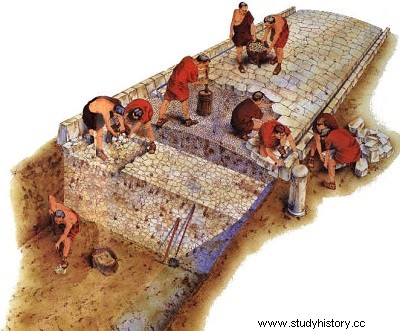
When the construction decision had been taken, the delimitation of the route was then entrusted to surveyors, the agrimenseurs or mensores. These surveyors used a few tried and true instruments:
the groma, ancestor of the current surveyor's square was used to facilitate the drawing of right angles. It is made up of four branches and fitted with five plumb lines which made it possible to draw perpendicular lines from a central point;
the chorobate, a large ruler (nearly 6 m) rigid on foot and dug in its upper part of a groove containing water. It was used for level calculation, making it possible to give a regular slope in raised areas;
the dioptre, an instrument consisting of a triangle fitted with a plumb line. It was used for leveling the road.
In general, Roman roads are characterized by great straightness. They avoid marshy areas and the immediate surroundings of watercourses as much as possible. When there was an obligation to cross, the way passed over a ford (small streams) or over a bridge, of wood or stone, of which there are still to this day magnificent examples still borrowed by the current road network. . In relief areas, they follow a mid-slope route, for convenience and safety reasons. Many routes also follow level curves, where their connections could be made abruptly, by steep slopes. better.
After taking the measurements, the surveyors staked out the route using markers. To complete the preparation of the route, clearing and logging took place.
The track site
Since the publication in 1622 of Nicolas Bergier's book Histoire des grands chemins de l'Empire romain in which the hypothesis of a three-layer construction of Roman roads was formulated for the first time, the idea of a construction obeying a standard scheme applied everywhere has been constantly taken over the centuries until in 1934 the archaeologist Albert Grenier demonstrates that it is only a view of the mind (modeled on what the we know, thanks to the Latin writings, of the construction of the ground and paving of the houses)1.
Generally, construction progressed simultaneously in several independent sections of varying distance. This fact explains the slight changes in orientation often observed. The construction is entrusted among others to the soldiers who thus find an occupation in times of peace. The sections thus created are near the military camps. The other sections are built by slaves, settlers of neighboring landowners and prisoners. Contrary to the generally accepted idea, the Roman road does not obey a typical standard but rather a set of sections of more or less good quality and more or less well maintained.
The layout was different depending on the topography of the ground (digging in flat ground, raising in trench-clearing in raised ground, backfilling-retaining for areas in depression).
The final profile of the pavement was curved, thus allowing an easy flow of rainwater towards drainage ditches located on each side. These ditches were sometimes used as a source of backfill material for maintenance.
The track being the privilege of troops, wagons and passenger cars, paths often double the tracks for the passage of pedestrians and riders.
